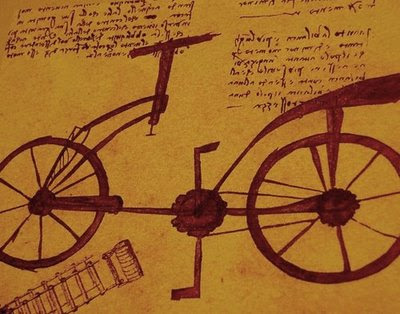
For much of man’s history on earth, he had two choices for getting around, either on foot or on the back of an animal (such as horses, mules, and wooly mammoths). Bicycles were developed to add another transportation option that multiplied human efficiency by a factor of approximately five.
But the history of bicycles is very fuzzy. Sources often disagree as to the names of the inventors and the dates of their inventions. Leonardo DaVinci sketched a facsimile of the modern bicycle in 1490. It was way ahead of its time and, as far as we know, never left the drawing board.
Around 1790 a French craftsman named de Sivrac developed a “Celerifere” running machine, which had two in-line wheels connected by a beam. The rider straddled the beam and propelled the Celerifere by pushing his feet on the ground, scooter fashion.
n 1817 German Baron Karl von Drais added steering. Several versions appeared around France and England by the early 1800s. As a replacement for the horse, these “hobby horses” became a short-lived craze. The roads of the time were too rutted to allow for efficient wheeled transport.
Scottish blacksmith Kirkpatrick MacMillan developed a rear-drive bike in 1839 using a treadle and rod for the rear drive mechanism. But, he lived in the Northern British Isles where people and ideas traveled slowly, so his invention didn’t spread. R.W. Thompson patented a pneumatic tube in 1845. Prior to this invention, bikes had metal wheels.
The French anointed Ernest Michaux “father of the bicycle,” as he and his brother Pierre added cranks and pedals. Their Velocipede started a bicycle boom. The larger front wheel made it faster but less stable. The war of 1812 brought an end to the French bicycle boom.
British engineers were next to pick up the design and improve upon it by adding ball bearings, pneumatic (Dunlop) tires, wire-spoked wheels, chain drive, variable gears, and cable controls. Over a twenty-year span, the British brought the bicycle to its present form, thanks mainly to James Starley of the Coventry Sewing Machine Company. In 1885 the Starley Rover safety bike was born, returning wheels to a reasonable size and improving the bike’s stability.
In the early days, women’s dress (corsets, pointed shoes, and voluminous skirts) limited their participation in this new sport. Newspapers of the day railed against the “sorcers” or bicycle speedsters.
07 September, 2009
Labels:
new bicycle blog,
new bike design,
new bikes,
new ebike,
new mountain bike,
wood bike parts,
wood bikes,
wood handle bars,
wood rims,
wooden bike handle bars
Posted by
Dale
7:00 AM
Subscribe to:
Post Comments (Atom)





Post a Comment 1 comments:
I enjoyed reading your blog ~ thanks for posting such useful content.
Dvinci Wheels and Tires Packages
October 11, 2011 at 12:51 AM